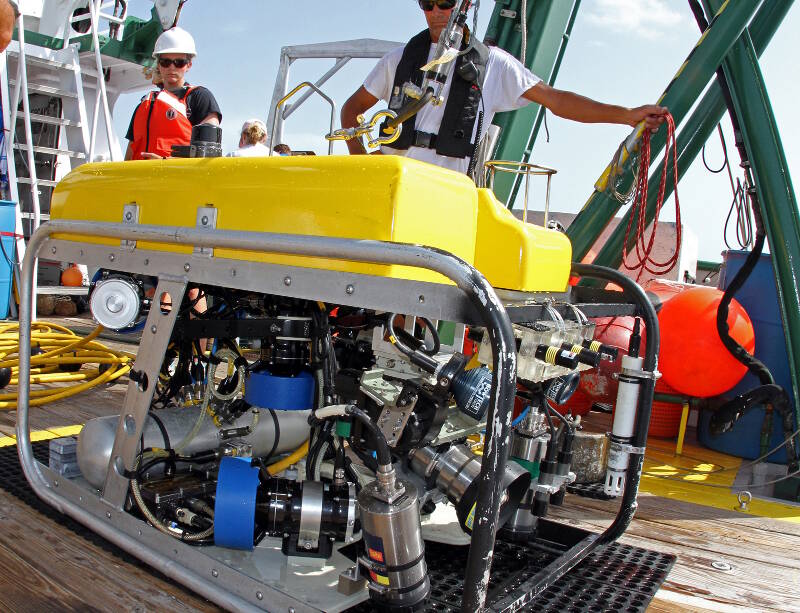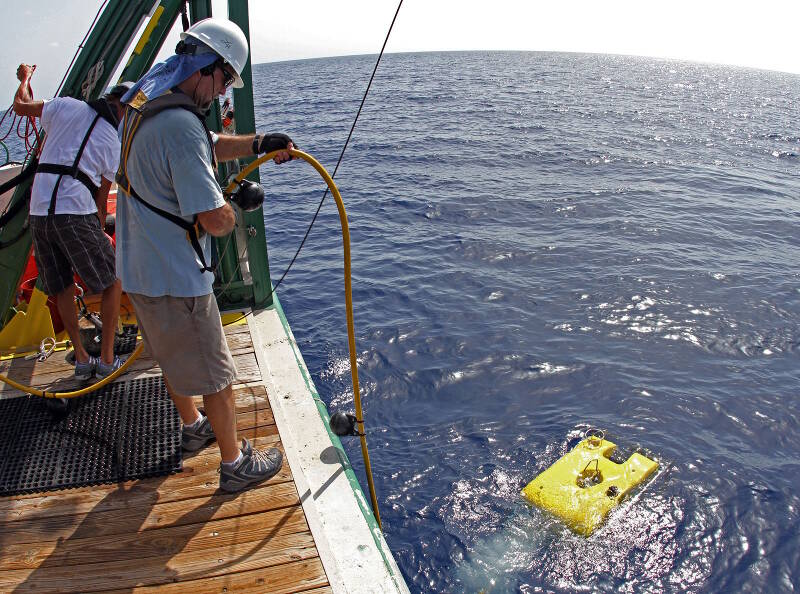
By Lance Horn, University of North Carolina at Wilmington, Undersea Vehicles Program
August 17, 2014
The remotely operated vehicle’s camera captures a spawning aggregation of sea urchins on Pulley Ridge. Video courtesy of Coral Ecosystem Connectivity 2014. Download (mp4, 3.8 MB)
My name is Lance Horn and I am half of the team that constitutes the Undersea Vehicles Program at the University of North Carolina at Wilmington. The other half of the remotely operated vehicle (ROV) team is Jason White. Each day, one of us works outside, while the other is inside.

The newest member of the University of North Carolina at Wilminton Undersea Vehicle Program team, ready for its first dive on Pulley Ridge. Image courtesy of Brian Cousin, FAU Harbor Branch. Download larger version (jpg, 1.0 MB).
It’s my turn to work out on the back deck of the R/V Walton Smith today. It is hot, hot, hot, with barely a breeze. My job is to coordinate the launch and recovery of the ROV, handle all of the tether management, and stand by to raise or lower the down weight as directed by the ROV pilot in case the depth of the ocean bottom changes. Keeping the ROV safe at the bottom of the ocean during the dive demands constant attention to cable management. At any given time, there is approximately 100 feet of cable that I have to manage. The cable supplies all of the power and communication to the ROV and it is imperative that we don’t let it get tangled or wrapped around objects on the bottom where it could be damaged or even parted in two.

Lance Horn manages the tether as the remotely operated vehicle moves away from the research vessel after hitting the water. Image courtesy of Brian Cousin, FAU Harbor Branch. Download larger version (jpg, 533 KB).
Jason White is taking his turn as the ROV pilot today. We swap off every other day. As ROV pilot, it is up to Jason to coordinate the ship’s movements with the ROV, ensure all of the ROV’s systems are operating correctly, and work with the scientists to acquire the best set of data possible in support of the research cruise. Piloting the ROV takes considerable concentration and can be mentally challenging, which is one of the main reasons that we alternate the pilot every day.
Operating the vehicle is only part of our job. When something breaks, we need to to fix it as quickly as possible. The science team is counting on us to keep the ROV running so that their objectives can be accomplished.

Jason White pilots the Mohawk remotely operated vehicle from the lab of the R/V Walton Smith. In the background, the science team logs volumes of data from the site, noting benthic features, as well as species of fish, invertebrates, and algae. Image courtesy of Brian Cousin, FAU Harbor Branch. Download larger version (jpg, 736 KB).
We are using a fairly new ROV, it is only a year old. It’s called a Mohawk ROV and it is made by Sub-Atlantic, a division of Forum Industries. The ROV is a fiber optic system that allows us to use a high definition video camera with broadcast quality video, control a multitude of ROV functions, and get feedback on the ROV’s system health during the dive. The system will alert us when a problem is occurring with the vehicle and how serious it is. We are continuously seeking to make improvements to the vehicle to make it easier for us to work with it, and to resolve some “bugs” that came with the system, which is sort of like debugging a piece of software in a computer. Our hard work has paid off because yesterday we did dives 80 and 81 on the new ROV, and they were the first dives we’ve had when no alarms occurred.
We go through “deck checks” before the dive to make sure all of the systems on the ROV are functioning correctly, including thrusters, casmeras, lights, lasers for scaling objects on the bottom, and the camera tilt platform. All of the acoustic tracking must be working properly so that we can geo-reference the video and digital stills. We want to make sure that we can provide a precise position for every image that we collect. The digital recording system is checked for storage space, a header file containing essential dive information is recorded for the dive, and voice recording levels on the microphone are checked so that the science team can record what they are looking at on the bottom onto the digital video recordings.
Once the dive begins, the science team informs us what information they require, and we are responsible for operating the ROV to achieve their goals. It’s very satisfying for us when the science team tells us they had a good day, which means we successfully completed our job.